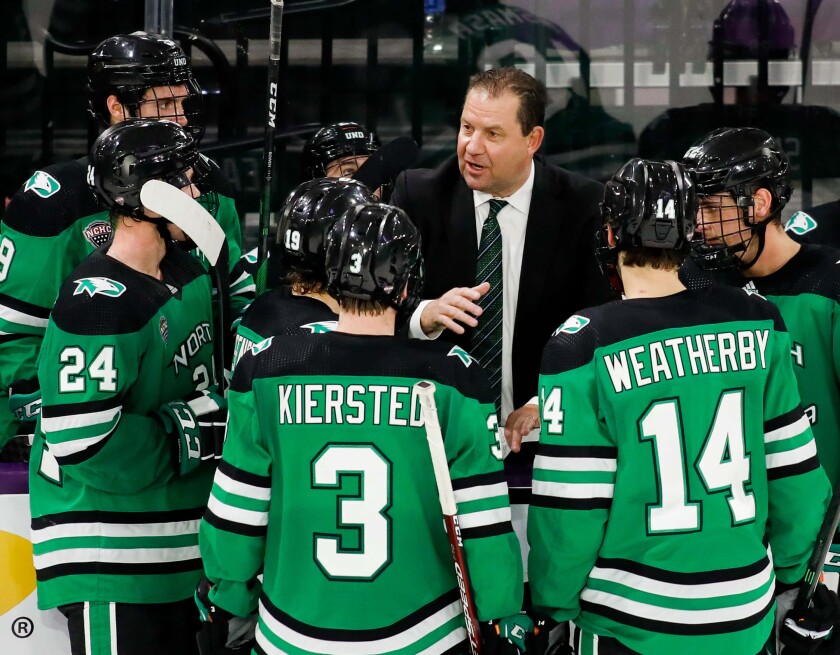Editor’s note: In Part 1 of a three-part series looking at the lives of NCAA Division I men’s hockey assistant coaches, former assistants Jason Herter, Brett Larson and Brad Berry summarize the challenges faced by modern day assistants, and how their jobs compare to others in the game.
DULUTH, Minn. — Former Minnesota Duluth assistant and associate head coach Jason Herter, who stepped down this spring after nine seasons with the Bulldogs, has been told by colleagues in professional hockey there is no harder job in the sport than being an assistant coach at the college level.
ADVERTISEMENT
Brett Larson, the current head coach at St. Cloud State and former assistant with UMD and the Ohio State Buckeyes, has heard it from friends in the pros as well.
As for North Dakota head coach Brad Berry, no one has to tell him about how the job compares having worked as an assistant in the NCAA, AHL and NHL.
“There are a lot of demands. It’s probably not for everybody,” said Berry, who was elevated to head coach in 2015 after nine seasons as a Fighting Hawks assistant — with a six-year break to coach and scout in the pros. “At the end of the day, you got to love what you do. You got to love going to the rink and doing what you’re doing, even though that gets to maybe be a little bit of a grind.”
While modern day NCAA Division-I men’s hockey assistant coaches may not have to wear as many hats as they once did, the demands of the job have never been higher thanks to bigger budgets, the competitive nature of those in the profession and a recruiting cycle that can only be slowed down — but not halted — by a global pandemic.
It’s an underrated position in the game as well, one that doesn’t receive the accolades it deserves despite assistant coaches doing just as much work as the head coaches they work for, Berry said. The lack of recognition is something he and Larson say they both realize now, having moved on to become head coaches in the ultra-competitive NCHC.
“As an assistant coach you've always got this battle with your time, because a big part of your job may be working with one of the special teams, and either the forwards or the 'D,'” said Larson, the Duluth native who coached under Scott Sandelin at UMD for six seasons (2008-11, 2015-18) and at OSU for two seasons (2013-15) under former Sandelin assistant Steve Rholik.
“You have those day-to-day responsibilities," Larson said, "yet at the same time, a huge part of your job is recruiting — whether it's making phone calls and emails, touching base with junior coaches, high school coaches, midget coaches, advisors and the players themselves. You have two really important things pulling at your time every day.”
ADVERTISEMENT

College vs. the pros
Current and former assistant coaches interviewed for this series — including longtime NCAA assistants Mike Gibbons and Dave Shyiak — said in-season, their time is split about 50-50 between recruiting and coaching, though once the season ends, it’s all recruiting — with this offseason being the exception due to COVID-19.
Meanwhile, their colleagues in the AHL and NHL are taking the summer off to spend time with family and recharge.
“You’re doing it all on the college side of it,” said Berry, who spent two seasons as an assistant coach with the AHL’s Manitoba Moose, two seasons as a scout with the Vancouver Canucks and two seasons as an NHL assistant with the Columbus Blue Jackets before returning to Grand Forks in 2012. “At the pro level, when you’re coaching, you’re coaching.”
Berry said it’s not just that professional coaches don’t have to scout and recruit players — that’s what the scouting department and general managers are for — it’s that pro coaches don’t have any time to do anything else but coach during a 76-game AHL regular season or 82-game NHL schedule.
“I’ll tell you what, when you were going, you were going 100 miles an hour,” Berry said. “There was no stopping. You’d get to the rink at 6 a.m. and wouldn’t leave until 6 p.m. and on game nights, it was probably midnight. You didn’t see your family at all.
ADVERTISEMENT
“Then you’re on the road and you could be gone — depending where you’re playing and what market you’re in — for a week or two weeks.”

Road warriors
Of course, it’s not uncommon for assistant coaches to find themselves on the road for a week or more at a time — even in season, on top of weekend road trips with the team — scouting and recruiting throughout Canada. That’s even more true for programs that aren’t within a day’s drive of junior teams in the United States Hockey League or North American Hockey League.
With head coaches tied to home base, it’s the assistants who often rotate hitting the road for extended recruiting trips, missing practices and games to do so.
“The way I always looked at it is, I don’t know how many days I was on the road, but the only time I could count to be off the road were a couple weeks in May and a couple weeks in August,” Larson said of his days as an assistant.
Since becoming the head coach of the Huskies in 2018, Larson said he’s physically home with his family more than when he was an assistant with the Bulldogs and Buckeyes.
ADVERTISEMENT
However, as his wife notes, there is a catch.
“Mentally, I am not,” Larson said of life as a head coach. “(As an assistant) when I would get home and after dinner, if I didn’t have any calls, I found it a little bit easier to turn my mind off and enjoy my family. As a head coach — I’m hoping this comes with experience — I haven’t found that as easy yet.”
Herter said he always took what his friends in pro hockey said as a compliment, not a dig on college hockey.
“It’s a different life. Very rewarding, don’t get me wrong, in a lot of ways,” Herter said. “But I don’t think people — unless they are close to assistant or head coaches — understand the pressure to be good when you build a program, the pressure to be great, to continue to make your mark on your school history.
“Because we’re so competitive, it eats at you. When you’re not on the road, not finding players, it just eats at you.”
Up next: In Part 2 of a three-part series looking at the lives of NCAA Division I men’s hockey assistant coaches, a look at how recruiting has become a year round job, and the toll that takes on assistant coaches.








